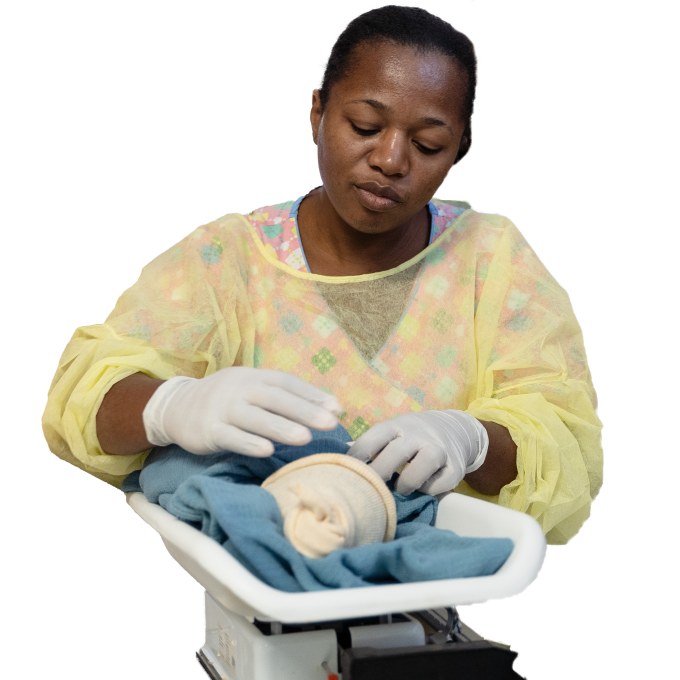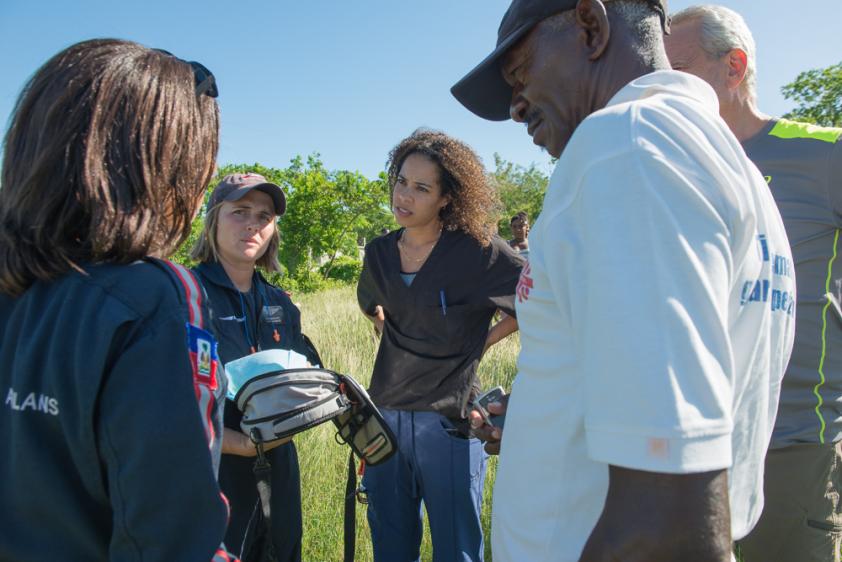“I never tire of providing care, so that mothers can experience the joy of holding a healthy baby again.”
Your donation will help Nurse Pascale save lives in our NICU.

A young woman named Claudine Beaubrun walked through the hospital in Les Cayes on Tuesday, November 1, visiting patients and reading to them from her bible. She did not need to be there—she had chosen to visit on her day off from school to bring comfort to the patients. While making her rounds, she saw an incubator where a tiny baby, hardly bigger than a soda bottle, lay wearing a onesie that was far too big for him.
His name was Moise.
His grandfather, Felix, who was lingering nearby, said the incubator only worked when the electricity was running–about 10 hours each day. Moise had not had any specialized care since he was born the day before. Born three months early, he had not received the surfactant that is usually necessary to help premature babies’ lungs develop and work properly. He also had not had an IV-drip or proper feeding. It was a miracle he was still alive, and Claudine decided to take it upon herself to make sure this miracle baby got the treatment he needed.
She searched the hospital for someone who could help. The nurses were at a loss, and almost afraid to touch the tiny baby without a doctor’s guidance. And there were no doctors at the hospital that day.
Then Claudine saw an American woman, also visiting the hospital, and asked if she could help. Caitlin Clarke, who works for the Notre Dame Mission Volunteers in Les Cayes, knew of SBH and the NICU at St. Boniface Hospital, and called Kevin Melanson to ask what could be done. Kevin connected her with Dr. Samuel Bernard, Medical Director at SBH, and with Haiti Air Ambulance, who agreed to transport the baby in their helicopter.
But outside, events were transpiring to once again make life more difficult for the little boy. An unorganized distribution of food aid in Les Cayes on Tuesday afternoon turned violent, and it was not safe to drive from the hospital to the helicopter landing site. Moise would have to wait another day.

Dr. Danica Gomes, the flight staff at Haiti Air Ambulance, and Grandpa Felix talk about baby Moise’s condition upon arrival at SBH’s helicopter landing site.
In the meantime, Dr. Bernard and a pediatrician from SBH got on the phone with the nurses in Les Cayes and talked them through giving the baby glucose and an IV-drip to help keep him alive until he could get to the NICU. With that advice, the staff in Les Cayes felt better prepared to do the basics of care for the next 24 hours. Claudine stayed with Moise and his grandfather, and Caitlin continued to help coordinate all of the people who now wanted to make sure this baby would make it.
As Caitlin and Claudine talked with Felix, more of the baby’s story became clear. His mother, Jessita, fell down while trying to get to shelter during Hurricane Matthew. She was about five months pregnant at the time, and for the next three weeks, she experienced on and off pains. By October 30th the pains progressed into full labor, and she delivered her son at the hospital in Les Cayes on the morning of October 31.
She and her husband Fednor left the hospital thinking there was no way the baby would survive and needing to seek treatment for Jessita elsewhere. However, on Tuesday her father Felix returned and discovered the little boy still fighting for life.
Wednesday morning, Les Cayes was calmer. Haiti Air Ambulance arrived around 1:00, and Claudine met them with little Moise and his grandfather, Felix. Moise was cold, and his diaper was wet. Neonates lose heat very quickly, so keeping him warm and dry for the flight was a top priority. HAA does not normally transport premies, so they didn’t have any specialized equipment on board. They heated some soft towels and wrapped them around his tiny body, and then placed him in an open insulated lunch box to try to maintain the warmth. “We innovated,” explained the flight nurse, wryly.
The drive from Les Cayes to Fond des Blancs takes about 2.5 hours, but by helicopter, the little baby and his grandfather arrived at SBH in just about 25 minutes.
They were met by SBH’s Head of Emergency Medicine, Dr. Danica Gomes, and COO Bill Gimson, along with a large group of community members curious about the helicopter’s tiny cargo. The baby, still in his towels and lunchbox, arrived at the SBH’s NICU and was immediately put into one of our 5 incubators, and hooked up to IVs and monitors. His oxygen and blood sugar levels were surprisingly within normal ranges for a premie of his size. “He’s a tough little guy,” the HAA flight nurse said, and everyone agreed. Grandpa Felix watched as Moise finally started getting the care he deserved, and glowed with pride and relief that his grandson was in good hands.
Moise gets settled in an incubator in SBH’s Neonatal Intensive Care Unit.
So many things—some bad, some good—came together to bring this baby to SBH.
A storm that forced an early labor.
A kindly visitor who took it upon herself to care for a stranger’s child.
A grandfather who didn’t give up.
Aid groups working together to ensure people get the help they need.
An Air Ambulance willing to try creative ways to transport a premature baby.
And most of all, a functioning referral hospital with a modern NICU prepared to care for a baby with complex needs.
Your donation will help Nurse Pascale save lives in our NICU.
